Steven Dubner - Freakonomics
The gulf between the information we publicly proclaim and the information we know to be true is often vast. (Or, put a more familiar way: we say one thing and do another.) This can be seen in personal relationships, in commercial transactions, and of course in politics.
By now we are fully accustomed to the false public proclamations of politicians themselves. But voters lie too. Consider an election between a black candidate and a white candidate. Might white voters lie to pollsters, claiming they will vote for the black candidate in order to appear more color-blind than they actually are? Apparently so. In New York City’s 1989 mayoral race between David Dinkins (a black candidate) and Rudolph Giuliani (who is white), Dinkins won by only a few points. Although Dinkins became the city’s first black mayor, his slender margin of victory came as a surprise, for pre-election polls showed Dinkins winning by nearly 15 points. When the white supremacist David Duke ran for the U.S. Senate in 1990, he garnered nearly 20 percent more of the vote than pre-election polls had projected, an indication that thousands of Louisiana voters did not want to admit their preference for a candidate with racist views.
Duke, though he never won the high political office he often sought, proved himself a master of information abuse. As Grand Wizard of the Knights of the Ku Klux Klan, he was able to compile a mailing list of thousands of rank-and-file Klansmen and other supporters who would eventually become his political base.
Not content to use the list only for himself, he sold it for $150,000 to the governor of Louisiana. Years later, Duke would once again use the list himself, letting his supporters know that he’d fallen on hard times and needed their donations. In this way Duke was able to raise hundreds of thousands of dollars for his continuing work in the field of white supremacy. He had explained to his supporters in a letter that he was so broke that the bank was trying to repossess his house.
In truth, Duke had already sold his house for a solid profit. (It isn’t known whether he used a real-estate agent.) And most of the money he raised from his supporters was being used not to promote any white supremacist cause but rather to satisfy Duke’s gambling habit. It was a sweet little scam he was running—until he was arrested and sent to federal prison in Big Spring, Texas.
Levitt fits everywhere and nowhere. He is a noetic butterfly that no one has pinned down (he was once offered a job on the Clinton economic team, and the 2000 Bush campaign asked him about being a crime advisor) but who is claimed by all. He has come to be acknowledged as a master of the simple, clever solution. He is the guy who, in the slapstick scenario, sees all the engineers futzing with a broken machine—and then realizes that no one has thought to plug it in.
—THE N EW Y ORK T IMES M AGAZINE, AUGUST 3, 2003
3
Why Do Drug Dealers Still Live with Their
Moms?
The two previous chapters were built around a pair of admittedly freakish questions: What do schoolteachers and sumo wrestlers have in common? and How is the Ku Klux Klan like a group of real-estate agents? But if you ask enough questions, strange as they seem at the time, you may eventually learn something worthwhile.
The first trick of asking questions is to determine if your question is a good one.
Just because a question has never been asked does not make it good. Smart people have been asking questions for quite a few centuries now, so many of the questions that haven’t been asked are bound to yield uninteresting answers.
But if you can question something that people really care about and find an answer that may surprise them—that is, if you can overturn the conventional wisdom—then you may have some luck.
It was John Kenneth Galbraith, the hyperliterate economic sage, who coined the phrase “conventional wisdom.” He did not consider it a compliment. “We associate truth with convenience,” he wrote, “with what most closely accords with self-interest and personal well-being or promises best to avoid awkward effort or unwelcome dislocation of life. We also find highly acceptable what contributes most to self-esteem.” Economic and social behavior, Galbraith continued, “are complex, and to comprehend their character is mentally tiring.
Therefore we adhere, as though to a raft, to those ideas which represent our understanding.”
So the conventional wisdom in Galbraith’s view must be simple, convenient, comfortable, and comforting—though not necessarily true. It would be silly to argue that the conventional wisdom is never true. But noticing where the conventional wisdom may be false—noticing, perhaps, the contrails of sloppy or self-interested thinking—is a nice place to start asking questions.
Consider the recent history of homelessness in the United States. In the early 1980s, an advocate for the homeless named Mitch Snyder took to saying that there were about 3 million homeless Americans. The public duly sat up and took notice. More than 1 of every 100 people were homeless? That sure seemed high, but…well, the expert said it. A heretofore quiescent problem was suddenly catapulted into the national consciousness. Snyder even testified before Congress about the magnitude of the problem. He also reportedly told a college audience that 45 homeless people die each second—which would mean a whopping 1.4
billion dead homeless every year. (The U.S. population at the time was about 225
million.) Assuming that Snyder misspoke or was misquoted and meant to say that one homeless person died every forty-five seconds, that’s still 701,000 dead homeless people every year—roughly one-third of all deaths in the United States.
Hmm. Ultimately, when Snyder was pressed on his figure of 3 million homeless, he admitted that it was a fabrication. Journalists had been hounding him for a specific number, he said, and he hadn’t wanted them to walk away empty-handed.
It may be sad but not surprising to learn that experts like Snyder can be self-interested to the point of deceit. But they cannot deceive on their own. Journalists need experts as badly as experts need journalists. Every day there are newspaper pages and television newscasts to be filled, and an expert who can deliver a jarring piece of wisdom is always welcome. Working together, journalists and experts are the architects of much conventional wisdom.
Advertising too is a brilliant tool for creating conventional wisdom. Listerine, for instance, was invented in the nineteenth century as a powerful surgical antiseptic. It was later sold, in distilled form, as a floor cleaner and a cure for gonorrhea. But it wasn’t a runaway success until the 1920s, when it was pitched as a solution for “chronic halitosis”—a then obscure medical term for bad breath.
Listerine’s new ads featured forlorn young women and men, eager for marriage but turned off by their mate’s rotten breath. “Can I be happy with him in spite of that?” one maiden asked herself. Until that time, bad breath was not conventionally considered such a catastrophe. But Listerine changed that. As the advertising scholar James B. Twitchell writes, “Listerine did not make mouthwash as much as it made halitosis.” In just seven years, the company’s revenues rose from $115,000 to more than $8 million.
However created, the conventional wisdom can be hard to budge. Paul Krugman, the New York Times columnist and devout critic of George W. Bush, bemoaned this fact as the President’s reelection campaign got under way in early 2004: “The approved story line about Mr. Bush is that he’s a bluff, honest, plainspoken guy, and anecdotes that fit that story get reported. But if the conventional wisdom were instead that he’s a phony, a silver-spoon baby who pretends to be a cowboy, journalists would have plenty of material to work with.”
In the months leading up to U.S. invasion of Iraq in 2003, dueling experts floated diametrically opposite forecasts about Iraq’s weapons of mass destruction. But more often, as with Mitch Snyder’s homeless “statistics,” one side wins the war of conventional wisdom. Women’s rights advocates, for instance, have hyped the incidence of sexual assault, claiming that one in three American women will in their lifetime be a victim of rape or attempted rape. (The actual figure is more like one in eight—but the advocates know it would take a callous person to publicly dispute their claims.) Advocates working for the cures of various tragic diseases regularly do the same. Why not? A little creative lying can draw attention, indignation, and—perhaps most important—the money and political capital to address the actual problem.
Of course an expert, whether a women’s health advocate or a political advisor or an advertising executive, tends to have different incentives than the rest of us.
And an expert’s incentives may shift 180 degrees, depending on the situation.
Consider the police. A recent audit discovered that the police in Atlanta were radically underreporting crime since the early 1990s. The practice apparently began when Atlanta was working to land the 1996 Olympics. The city needed to shed its violent image, and fast. So each year thousands of crime reports were either downgraded from violent to nonviolent or simply thrown away. (Despite these continuing efforts—there were more than 22,000 missing police reports in 2002 alone—Atlanta regularly ranks among the most violent American cities.) Police in other cities, meanwhile, were spinning a different story during the 1990s. The sudden, violent appearance of crack cocaine had police departments across the country scrapping for resources. They made it known that it wasn’t a fair fight: the drug dealers were armed with state-of-the-art weapons and a bottomless supply of cash. This emphasis on illicit cash proved to be a winning effort, for nothing infuriated the law-abiding populace more than the image of the millionaire crack dealer. The media eagerly glommed on to this story, portraying crack dealing as one of the most profitable jobs in America.
But if you were to have spent a little time around the housing projects where crack was so often sold, you might have noticed something strange: not only did most of the crack dealers still live in the projects, but most of them still lived at home with their moms. And then you may have scratched your head and said,
“Why is that?”
The answer lies in finding the right data, and the secret to finding the right data usually means finding the right person—more easily said than done. Drug dealers are rarely trained in economics, and economists rarely hang out with crack dealers. So the answer to this question begins with finding someone who did live among the drug dealers and managed to walk away with the secrets of their trade.
Sudhir Venkatesh—his boyhood friends called him Sid, but he has since reverted to Sudhir—was born in India, raised in the suburbs of upstate New York and southern California, and graduated from the University of California at San Diego with a degree in mathematics. In 1989 he began to pursue his PhD in sociology at the University of Chicago. He was interested in understanding how young people form their identities; to that end, he had just spent three months following the Grateful Dead around the country. What he was not interested in was the grueling fieldwork that typifies sociology.
But his graduate advisor, the eminent poverty scholar William Julius Wilson, promptly sent Venkatesh into the field. His assignment: to visit Chicago’s poorest black neighborhoods with a clipboard and a seventy-question, multiple-choice survey. This was the first question on the survey: How do you feel about being black and poor?
1. Very bad
2. Bad
3. Neither bad nor good
4. Somewhat good
5. Very good
One day Venkatesh walked twenty blocks from the university to a housing project on the shore of Lake Michigan to administer his survey. The project comprised three sixteen-story buildings made of yellow-gray brick. Venkatesh soon discovered that the names and addresses he had been given were badly outdated. These buildings were condemned, practically abandoned. Some families lived on the lower floors, pirating water and electricity, but the elevators didn’t work. Neither did the lights in the stairwell. It was late afternoon in early winter, nearly dark outside.
Venkatesh, who is a thoughtful, handsome, and well built but not aberrationally brave person, had made his way up to the sixth floor, trying to find someone willing to take his survey. Suddenly, on the stairwell landing, he startled a group of teenagers shooting dice. They turned out to be a gang of junior-level crack dealers who operated out of the building, and they were not happy to see him.
“I’m a student at the University of Chicago,” Venkatesh sputtered, sticking to his survey script, “and I am administering—”
“Fuck you, nigger, what are you doing in our stairwell?”
There was an ongoing gang war in Chicago. Things had been violent lately, with shootings nearly every day. This gang, a branch of the Black Gangster Disciple Nation, was plainly on edge. They didn’t know what to make of Venkatesh. He didn’t seem to be a member of a rival gang. But maybe he was some kind of spy?
He certainly wasn’t a cop. He wasn’t black, wasn’t white. He wasn’t exactly threatening—he was armed only with his clipboard—but he didn’t seem quite harmless either. Thanks to his three months trailing the Grateful Dead, he still looked, as he would later put it, “like a genuine freak, with hair down to my ass.”
The gang members started arguing over what should be done with Venkatesh.
Let him go? But if he did tell the rival gang about this stairwell hangout, they’d be susceptible to a surprise attack. One jittery kid kept wagging something back and forth in his hands—in the dimming light, Venkatesh eventually realized it was a gun—and muttering, “Let me have him, let me have him.” Venkatesh was very, very scared.
The crowd grew, bigger and louder. Then an older gang member appeared. He snatched the clipboard from Venkatesh’s hands and, when he saw that it was a written questionnaire, looked puzzled.
“I can’t read any of this shit,” he said.
“That’s because you can’t read,” said one of the teenagers, and everyone laughed at the older gangster.
He told Venkatesh to go ahead and ask him a question from the survey.
Venkatesh led with the how-does-it-feel-to-be-black-and-poor question. It was met with a round of guffaws, some angrier than others. As Venkatesh would later tell his university colleagues, he realized that the multiple-choice answers A through E were insufficient. In reality, he now knew, the answers should have looked like this:
1. Very bad
2. Bad
3. Neither bad nor good
4. Somewhat good
5. Very good
6. Fuck you
Just as things were looking their bleakest for Venkatesh, another man appeared.
This was J. T., the gang’s leader. J. T. wanted to know what was going on. Then he told Venkatesh to read him the survey question. He listened but then said he couldn’t answer the question because he wasn’t black.



